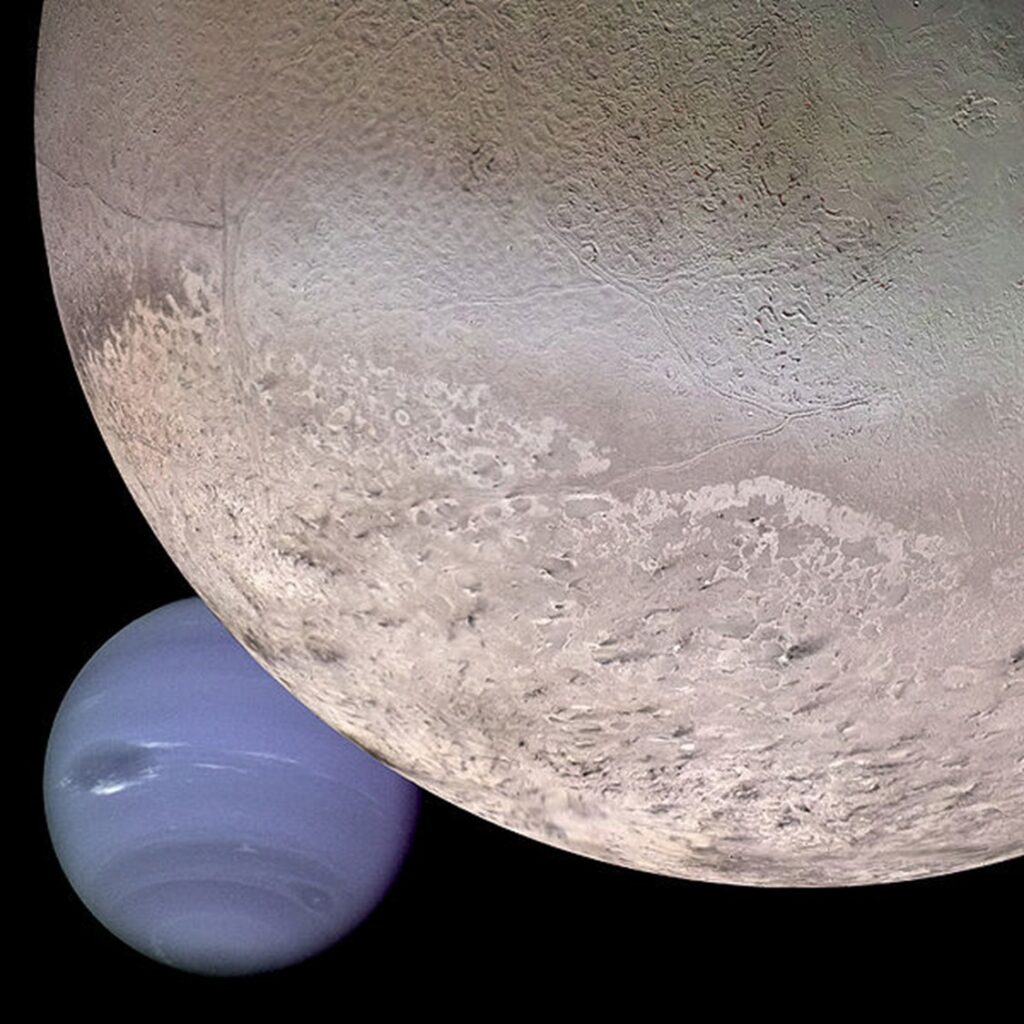
Artist rendering of Saturn’s icy moon Enceladus, with a plume of ice particles, water vapor and organic molecules spraying from fractures in the moon’s south polar region. Image: NASA.
Life, As We Know It, Has Always Been Dependent On Water.
In fact, scientists have traced the beginning of life on Earth billions of years ago to deep under the oceans that now cover more than two-thirds of the planet’s surface. Now, as we continue to search for possible habitable places beyond our home planet, we begin to unravel the secrets of other ocean worlds in our solar system. Could we one day move to one of them? What kind of native life might already be there? Questions like these are behind some missions of NASA and the European Space Agency (ESA), and we may start getting some answers very shortly – well, relatively speaking.
Ocean worlds with a substantial amount of water either on or below their surfaces can be planets, moons and other rocky bodies. Today we know of a number of such places in our solar system. Examples include Jupiter’s moon Europa, Saturn’s moons Titan and Enceladus, and Neptune’s moon Triton.

Jupiter’s ice-covered satellite, Europa, in approximate natural color. Long, dark lines are fractures in the crust, some of which are more than 3,000 kilometers (1,850 miles) long. Europa is about the size of Earth’s moon. This image was taken on September 7, 1996, by the Galileo spacecraft. NASA.
Europa is one of the Galilean moons.
Its surface is mostly water ice, and scientists believe that beneath the icy crust may be an ocean of liquid water. According to NASA, “Europa’s ice shell is 10 to 15 miles (15 to 25 kilometers) thick, floating on an ocean 40 to 100 miles (60 to 150 kilometers) deep.” This incredible amount of water would explain why Europa is “widely considered the most promising place to look for life beyond Earth”. However, although this moon of Jupiter might have water and other important chemical elements for life, scientists are uncertain about its potential energy sources. Without sufficient energy, it could be that any life we may find there could be limited to microorganisms that are either single-celled or clusters of cells.
“The Galilean moons, or Galilean satellites, are the four largest moons of Jupiter: Io, Europa, Ganymede, and Callisto. They were first seen by Galileo Galilei in [1609-1610]. They were the first objects found to orbit a planet other than the Earth [and] are among the largest objects in the Solar System” (Wikipedia).
Until now, a total of five spacecraft have visited Europa, and our knowledge of Jupiter’s moons has come mainly from observations using the Galileo spacecraft. Today, scientists monitor this moon using the Hubble Space Telescope. Soon, however, we will have more dedicated observers as two new spacecraft are expected to shed more light on Jupiter’s moons: NASA’s Europa Clipper, expected to “launch in the mid-2020s and spend several years traveling to Jupiter”, and ESA’s JUICE (Jupiter Icy moons Explorer).
JUICE – JUpiter ICy moons Explorer – is “the first large-class mission in ESA’s Cosmic Vision 2015-2025 programme.” Now stationed at French Guyana in preparation for launch in April 2023, it will spend at least three years making detailed observations of Jupiter and three of its largest moons, Ganymede, Callisto and Europa. (ESA’s website).

“Computer-generated montage showing Neptune as it would appear from a spacecraft approaching Triton, Neptune’s largest moon”. Image: NASA.
Another ocean world that might harbor life could be Neptune’s moon Triton.
Discovered in 1846 by British astronomer William Lassell, shortly after the discovery of the blue planet, Triton is the largest of Neptune’s thirteen moons. Triton is 1,680 miles (2,700 kilometers) wide, and, as NASA explains, “like our own moon, Triton is locked in synchronous rotation with Neptune―one side faces the planet at all times. But because of its unusual orbital inclination both polar regions take turns facing the Sun”. However, Triton is extremely cold – in fact it’s one of the coolest objects in our solar system – and scientists believe there is more rock in its interior than other ocean worlds such as Saturn’s moons.
“Neptune’s atmosphere is made up of hydrogen, helium and methane. The methane in Neptune’s upper atmosphere absorbs the red light from the sun but reflects the blue light from the Sun back into space. This is why Neptune appears blue” (Caltech).

Artist’s impression of possible hydrothermal activity on Enceladus’s ocean floor, referring to the geyser-like jets of water vapor and ice particles escaping from beneath the icy crust of the moon. Image: NASA/JPL-Caltech.
Frigid Triton: “NASA’s Voyager 2―the only spacecraft to fly past Neptune and Triton―found surface temperatures of -391degrees Fahrenheit (-235 degrees Celsius). During its 1989 flyby, Voyager 2 also found Triton has active geysers, making it one of the few geologically active moons in our solar system” (NASA).
But it’s one of Saturn’s moons, Enceladus, that has recently become the most popular candidate for hosting ocean life.
Between 2008 and 2015, NASA’s Cassini mission captured with unprecedented detail the plumes of water erupting from the surface of the brightest of Saturn’s moons. “Cassini basically sniffed Enceladus’ plumes. What it found was not only evidence of liquid salt water but also that it was warm”, said Caitlin Ahrens, a NASA postdoctoral researcher at Goddard Space Flight Center. In a 2016 paper for the American Astronomical Society, Dr. Linda Spilker and Dr. Morgan Cable, planetary scientists at NASA’s Jet Propulsion Laboratory, wrote:
“Life as we know it requires liquid water, organic chemistry and energy. As Cassini discoveries have shown, all of these key ingredients appear to exist on Saturn’s tiny moon Enceladus, making it a possible habitat for life. (…) Cassini’s sensitive instruments discovered complex organic molecules, salts and silicates in the plume indicating that the water is in contact with a rocky core. (…). The ocean is salty, much like our own seas. Excess heat originates from the narrow tiger stripes and tiny silica nanograins in the plume provide evidence for hydrothermal activity on Enceladus’ seafloor. Similar hydrothermal systems on Earth support rich communities of life that contain organisms as large as tubeworms and crabs. With each discovery, Enceladus becomes an increasingly enticing astrobiology target.”
However, to finally answer the question of whether there is life on Enceladus, we will need more specialized equipment and targeted missions. That’s why scientists who authored the 2022 planetary decadal survey have recommended as their third-highest priority sending a mission to Enceladus that could orbit and land on Saturn’s tiny moon in the 2050s – that is, of course, if funding allows.
“The Enceladus Orbilander is a proposed NASA Flagship mission to Saturn’s moon Enceladus. [It] would spend a year and a half orbiting Enceladus and sampling its water plumes, which stretch into space, before landing on the surface for a two-year mission to study materials for evidence of life. The mission, with an estimated cost of $4.9 billion, could launch in the late 2030s on a Space Launch System or Falcon Heavy with a landing in the early 2050s.” (Wikipedia).
The Enceladus Orbilander Mission Concept was outlined in a 2021 scientific paper, published in The Planetary Science Journal by Dr. Shannon MacKenzie, planetary scientist at the Johns Hopkins University Applied Physics Laboratory, and co-authors. According to Dr. MacKenzie, “We know there is a subsurface ocean, and we have every reason to suspect it is habitable. We have the technology to go and sample it. It’s just an opportunity waiting for us to take advantage of. I can’t think of a better place in the solar system to do the search for life in the near-future”.
In the future, we may find other ocean worlds that could support human life.
It could happen as soon as the next few decades, while scientists are developing ever more specialized technology as quickly as funding allows. This brings up many questions, among which is “what then?” What if we do find life? What if we could survive there? What if humans one day colonized another ocean world? What might have once seemed like science fiction is slowly becoming reality. Are we prepared?



